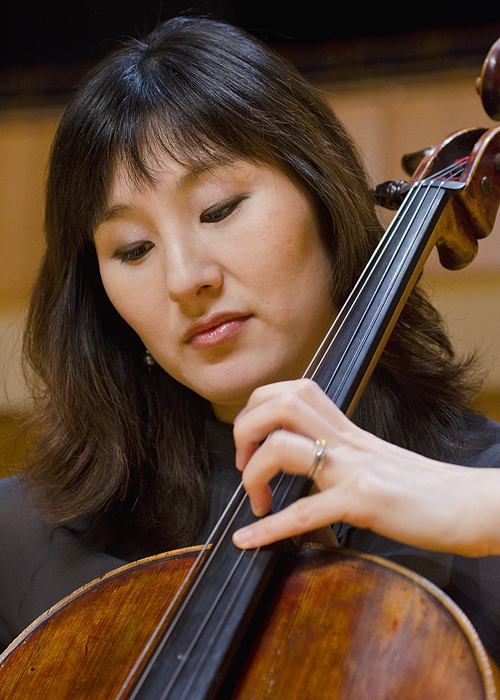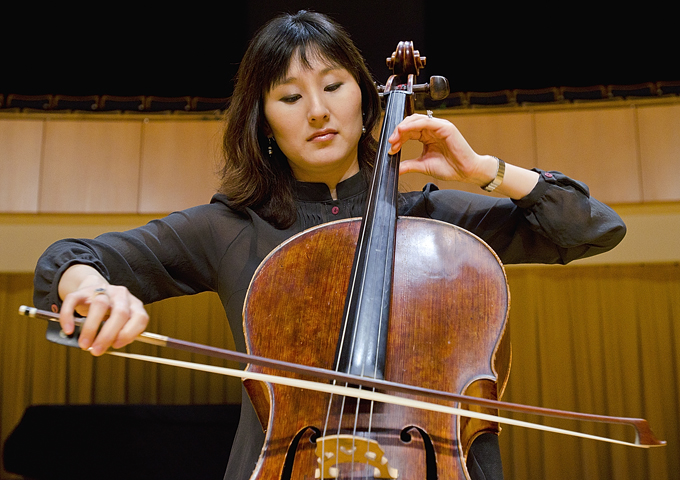Music Therapist Works To Give Children With Autism A Voice
Feb. 6, 2012
SHSU Media Contact: Jennifer Gauntt
|
|
| Hayoung Lim, coordinator of SHSU's graduate program in music therapy, is both a trained cellist and a researcher who has written extensively on the connections between music and developmental disabilities such as autism. Her first book outlines methods that can be used to help children with low-functioning autism develop vocabulary. Watch Lim perform a Korean hymn through the SHSU YouTube channel by clicking here. —Photos by Brian Blalock |
It is almost serendipitous the way that SHSU assistant professor and coordinator of the graduate program in music therapy Hayoung Lim found her calling in her field.
As an undergraduate, Lim was studying cello performance at the Catholic University of Korea in Seoul, South Korea, when a community service assignment that was part of the university’s sophomore curriculum placed her in a facility that cared for people with visual impairments and severe developmental delays.
Lim and her music peers were supposed to work in the kitchen, but when a sociology major asked to change roles because she was having difficulty coping with the severity of the boy with whom she was working, Lim volunteered to sit with the child.
“I went to a room and there was a 10-year-old boy with autism, and he was blind,” Lim said. “The teacher told me he could not do anything, but if you didn’t hold his hand, he would bang his head with his hand. He was physically fine but cognitively couldn’t do anything.”
When Lim grew bored with just sitting and holding the boy’s hand, she began humming. She soon found the boy copying the song, humming back to her.
“I thought (about how) the teacher told me he couldn’t do anything, but he had a beautiful voice and it was the right pitch and right rhythm,” she said. “So I just kept singing for him for three days.
“We would walk and just sing. He liked it,” she said. “While I was singing, even if I didn’t hold his hand, he didn’t bang his head. He was really responsive to the music.”
When Lim went back to school, she began researching music therapy. There were no programs of that kind in Korea at the time, so she decided to come to the United States to study.
She was offered scholarships at Illinois State University and, after earning master’s degrees in both cello performance and music therapy, moved to the University of Miami, where, during her research for her doctoral dissertation, she continued exploring the connection between children with developmental disabilities and music.
What she has found through her continued research could be seen as potentially groundbreaking for the skyrocketing number of children diagnosed with autism spectrum disorders world-wide.
Through her work with children with autism, Lim has been able to connect music to various speech-language acquisition principles that can actually help low-functioning children with autism, those who have the most difficulties following verbal commands, reading body languages and have deficits in social understanding, according to the Autism Speaks website.
Some low-functioning autistic children lack the ability to communicate at all, and that’s where Lim’s work can make the biggest impact.
Utilizing the Gestalt Perception Principle, Lim was able to figure out that children with autism have the same impulse trigger as people without autism to “fill in the blank” of a pattern.
 |
“The mechanism (can be witnessed) when I sing to you, ‘You are my…,’ and you fill in ‘sunshine’ naturally, because we cannot suppress the urge to fill out the incomplete form or pattern,” she said. “Even before you actually perceive this as ‘you are my sunshine,’ you really want to complete that part.”
While most children learn language analytically (adding words segment by segment) and through guess-talk (imitation and memorization of those around them), children with autism acquire language largely by guess-talk.
“Research has shown that children with autism do a lot of echolalia; that means if I ask, “Would you like to have a glass of milk?” they would just repeat, “Would you like to have a glass of milk?” instead of analyzing (the question to give a response),” Lim said. “Eighty-to-85 percent of children with autism who do some kind of speech do these echolalia responses. Their level is different though.”
Because music is based on the guess-talk principle, Lim has been able to devise a series of songs and pictures that can help train children with low-functioning autism to begin acquiring language.
For her dissertation, Lim compared the effectiveness of traditional speech-language training with speech-language training through music and found what she calls a significant effect.
“I found that music training is as effective as speech training for all children with autism,” she said. “When I divided children with autism into the different levels of function, high-level and low-level, I found that for low-functioning children with autism, music training has more of an effect on them. For high-functioning children, both music and speech are effective, but for low-functioning children, music is more effective.
“I had a lot of students who never had a functional vocabulary who just loved to respond to the music and then eventually they started to say words,” she said.
This work has received attention world wide, and she says she has been getting very positive feedback. Two of her studies have been published in prestigious music therapy journals, and London’s Jessica Kingsley Publishers recently printed her book on the effect of music on the speech-language acquisition of children with low-functioning autism.
Developmental Speech-Language Training through Music for Children with Autism Spectrum Disorders, which became available in November in the U.S., presents the theoretical explanations of why music therapy works with this population of children and also provides the clinical interventions—including the music, lyrics and images—that can be used by practitioners, teachers and parents.
While Lim said she only observed the speech-language effect of music on children with autism, she could also see a positive influence in other problematic areas for that group, including turn-taking, social interaction, and attention span.
“Speech-language is a major, critical problem, because parents tend to notice when something’s not right with their children because of the delay in speech or their ability to talk, so I just addressed this area more,” she said. “But once they communicate better with their parents or peers, tantrums decreased; they behaved better because they understand and communicate better. You see a chain effect from the increase in language.”
Lim said she doesn’t like to talk about treatment in terms of a “cure” (there is no cure for autism at this time) but instead prefers to focus on the progress children with autism make through this kind of work.
“If they can function at the maximum level, that is good,” she said. “I cannot function 100 percent, we don’t really utilize our resources 100 percent, but I can function as much as I can. I think that’s the cure; that’s the aim for the treatment.
“Not starting from what they cannot do but starting from what they can do is important as a therapist and as an educator. I really started this book and research from what they can do. I’m proud of that; that I didn’t focus on the disability,” she said. “Even though they have a language impairment they have brain activity, but their brain works differently. We have to find something they are able to do, and then we start to provide a treatment intervention and facilitate and develop that skill, ability and function.”
Although Lim has worked with many children since her undergraduate days in South Korea, she said she still thinks about the little boy who inspired her career.
“Until I really worked with children in autism, I had forgotten about him, but now I remember him,” she said. “It’s neat because he really made me study music therapy and I ended up writing a book about children with autism; so I really thank him.”
- END -
This page maintained by SHSU's Communications Office
Associate Director: Julia May
Manager: Jennifer Gauntt
Located in the 115 Administration Building
Telephone: 936.294.1836; Fax: 936.294.1834
Please send comments, corrections, news tips to Today@Sam.edu.

 SamWeb
SamWeb My Sam
My Sam E-mail
E-mail


